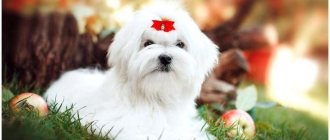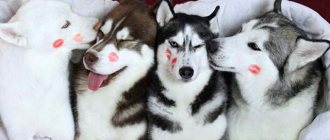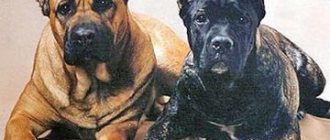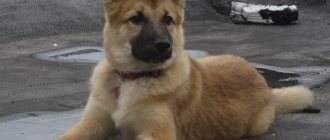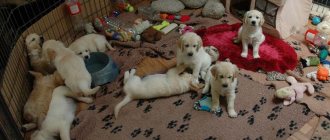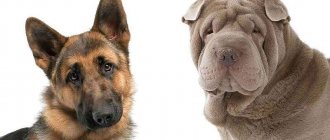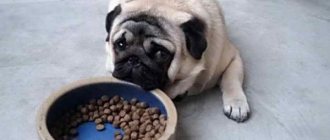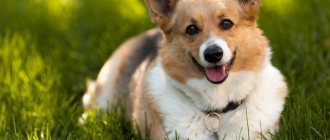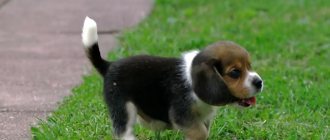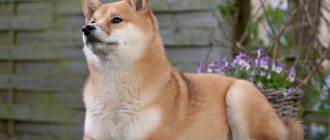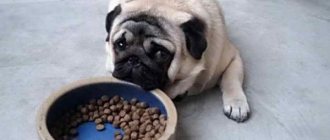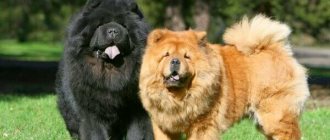The basic requirements for hunting dogs are strength, endurance, courage, devotion, and obedience. Raising and training such breeds differs from training ordinary domestic dogs.
Hunting dogs must be prepared to go without food for a long time in different climatic conditions. When choosing a suitable breed, it is recommended to pay attention to what animals the dogs are capable of tracking. The sociable qualities of an animal are also important, because a dog becomes a reliable partner for a person during a hunt.
Kurzhaar
The shorthaired pointer is a famous hunting breed bred in Germany. She is intelligent, quick-witted and amenable to training. These dogs require a lot of physical activity.
The breed is characterized by loyalty, friendliness towards the owner and family members, high performance and excellent watchdog qualities. It is easy to train a dog to be clean and tidy. The shorthaired pointer is used for hunting birds, hares, deer, and raccoons.
Representatives of the breed are excellent swimmers and perform the “fetch” command well. Dogs require constant training; they are ready to learn new things and easily master commands. The main thing in keeping a Shorthaired Pointer is to organize daily walks with minimal physical activity to maintain muscle tone.
Groups of hunting dogs
Which dogs are better at hunting? In fact, the types of hunting breeds are diverse and include not only greyhounds and hounds, as some believe. All dogs that are suitable for catching prey are divided into 6 main groups. A person’s success in pursuing game largely depends on the right choice.
Greyhounds
These are quite large dogs, very strong, and can easily bear loads. They have sharp eyesight and high running speed. Pets are suitable for catching foxes, small ungulates, and hares. The tactics for catching an animal are as follows: upon seeing it, the dog develops high speed, catches up, and strangles the animal. Dogs can be used in open areas, in forests, forest-steppes, but their sense of smell is not very sensitive.
Hounds
These beautiful short-haired dogs, bred specifically for hunting, are designed to catch hares, foxes, and wild boars. They have an excellent sense of smell, persistence in pursuing game, and great vitality. The description of the breeds is as follows: large animals with hanging long ears, brown coat color with large white and black spots.
Hunting with hounds goes like this: the pet finds the animal by smell, barks loudly and runs after it, driving it towards the owner. A person shoots from cover when the position is comfortable. These dogs do not kill game, they are very friendly, adore children, and do not harm other pets.
Burrows
These dogs are small, active, and are used to catch animals in burrows. They climb straight into the hole, chase the fox and badger out of the second exit towards the hunter. A dog can also pull an animal out of a hole with its teeth. In addition to burrowing animals, such pets are capable of hunting birds and hares. They have one minus - they do not get along with other animals in the apartment.
Likes
Laikas are considered universal and the most popular dogs in the “hunting top”. They can be chosen to catch any bird, fur-bearing animals, ungulates and even bears. They have an excellent sense of smell, endurance, and speed are also excellent. Likes, despite the name, are far from noisy. They chase the game, silently, having caught up, they do not allow them to come to their senses and run away with loud barking and driving, biting. Laikas kill ducks themselves and bring them to the owner. As a guard dog, huskies lose: they are too friendly.
Cops
These purebred animals serve as gun animals - at the moment of the shot they are next to the person, “under the gun.” Cops are hardy, patient, and have excellent instincts. Dogs are best suited for catching birds. Smelling it, the dog sneaks up, comes close and takes a stance, which is the “calling card” of the breed. The man gives the command to throw, the bird takes off, and a shot is heard. Afterwards, the cops help find the killed game in the swamp, on the water meadow.
Spaniels and retrievers
Some of these dogs in Russia work as service dogs. They are of medium size, have a good disposition, and an easy-going character. Dogs love water, which is why they are often used to hunt waterfowl. Animals are even able to dive after a duck that has gone under water. A distinctive feature is the absence of damage to game by the dog due to its careful attitude. The hunting instincts of such dogs are very high, but they get tired quickly and cannot run long distances.
Labrador Retriever
The breed has a water-repellent coat and webbed feet. Thanks to these characteristics, the Labrador Retriever swims well, so it is taken to hunt ducks, pheasants, grouse, and woodcock. Dogs have a gentle bite, so they practically do not damage their prey.
In the 18th century, Labradors were used by fishermen to collect their catch from nets. The breed is characterized by an athletic build, energy, good disposition, friendliness, and obedience.
Features of duck hunting
Duck hunting is common among hunters of all levels. But you also need to know the peculiarities of this fishery. The spring duck hunting period lasts about two weeks, after which you can hunt only from mid-August to the end of October. In spring you can only hunt drakes. This can be done in several ways - the first is approach hunting. The hunter looks for where the ducks live and, with the help of the dog, raises the game, shoots it, and his faithful assistant brings the prey.
Duck hunting from a porch differs only in that the hunter waits for the game, waiting in the boat. There must be experienced dogs here, because too old or young dogs, experiencing the excitement of the hunt, may not calculate their strength and drown.
Migration hunting includes feeding birds: in the evening, ducks fly to the field to feed, and in the morning they return to their pond. If you shoot a duck in a field, then most likely the flock will change its feeding location and they will need to be tracked again, so you need to shoot the game in the middle of the field and the pond. Here the dog will help find wounded animals and bring back prey.
There are also other types of waterfowl hunting: shooting from a hut or hunting with a decoy duck, but in such cases the use of dogs is infrequent, because here you need to have patience and not every one of them is able to wait and not scare the duck ahead of time.
Beagle
The peculiarity of the breed lies in its specific ringing bark and compact size. The dog is non-aggressive and howls loudly when in danger. The Beagle has a good sense of smell, a cheerful disposition, and high energy.
These dogs have a stubborn character, so they require special training and good discipline. The Beagle is distinguished by its friendliness, ease of care, cleanliness, endurance, and intelligence. He gets along well with the owner, children and pets.
The breed is a universal hunting dog, so it can be used to track rabbits, foxes, pheasants, and quails. A flock of beagles can be used when hunting large animals, wild boars, roe deer, and jackals.
Care and maintenance of dogs
For hunting dogs, a proper diet and good living conditions are very important. The room should be warm, without wind, dry, bright. You definitely need a walking area - from 6 square meters. m area, hidden from drafts and scorching sun. Felt and straw are used for bedding. Leftover food is regularly removed and dishes washed.
The animal's fur is kept in good condition. The dog is washed and combed at least once a month, and in the summer they give him the opportunity to swim in ponds. Ears are cleaned with hydrogen peroxide. Regular walks are important to keep fit. Feeding is carried out twice a day; meat, cereals, vitamin supplements, and vegetables are required. Some breeders practice sterilization of dogs, which will not affect hunting performance at all.
English pointer
The Pointer combines the characteristics of hounds, greyhounds and hunting dogs. The breed is distinguished by its strength, high energy, persistence and endurance, making it ideal for hunting.
The pointer can dive and is able to pursue prey for a long time, so it is used when hunting birds and hares. He is also characterized by good eyesight, search skills, attentiveness, and a keen sense of smell.
When the dog notices prey, he freezes, and his body stretches out, pointing at the victim. The dog has an instant reaction, friendliness, and loyalty. The Pointer loves being surrounded by people and does not show aggression.
Read Top 20 smallest dogs - small breeds
Which husky is best for hunting?
The science of hunting an animal with a companion involves special and careful criteria for choosing a reliable, faithful partner for the hunter. Simplicity or ease in the tactics of identifying your own hunting dog is unacceptable here. Despite the natural versatility of all types of the Laika breed, its genetic predisposition to hunting and the dog’s excellent physical characteristics, you should not get a dog from unverified or unworthy breeding sources.
It is impossible to make an important choice without a full study of the pedigree and assessment of important factors of huskies.
But which husky is best for hunting will require the hunter to first study certain literature, and after applying the knowledge in practice at the time of choosing a dog.
The Laika breed has several hunting priorities that distinguish its classes from other dogs: an excellent sense of touch in all three senses of the surrounding world, simplicity and speed of tracking an animal in harsh conditions, long hikes, versatility in training a dog for a specific type and category of prey.
But indirect, genetically innate signs are not the final methods for choosing the right puppies when adopting a husky. In order to choose this breed correctly, in addition to the requirements described above, it is worth carefully conducting an external examination of the dog’s puppies, noting the presence of important and obligatory elements in the dog
An examination of the dog’s appearance will help you buy a husky for productive hunting and not regret it. It should show:
The puppy has a correct jaw bite. The main external element, in which the upper jaw will be slightly longer than the lower jaw. The teeth should not have any signs of disease, the incisors should have a full set - six pieces on each jaw. The absence of any damage, injury or similar things is also a mandatory phenomenon of choice. The activity of the puppies' voices will show that the breeder is on the right path of choice;- The general activity of the animal, although an additional physical sign of the dog’s selection, shows the general health of the newborn hunter’s companion;
- At such a young age, the color of the pupils of a husky should be dark or brown. Gradually growing up, he will change and this phenomenon is considered the norm of the breed;
- An umbilical hernia or the presence of strange spots on the puppy’s tummy is a bad sign and its absence will have a positive effect in the future.
The second stage of choosing puppies refers to the assessment of the dog’s mandatory behavioral properties, in which it will be possible to understand whether it can become an effective companion and whether it will be effective on a hike:
- The first thing to do is look the puppy straight in the eyes. Create something similar to mental contact with him. If, after the loss, there is no connection between the potential breeder and the animal, the puppy is brave and well focused;
- Assessment of the behavior of a young husky during feeding. It is worth finding out whether the puppy strives for the mother’s rear nipples during the feeding process or not. Moreover, is his brothers and sisters a surmountable obstacle for him at this moment? If the dog energetically pushes them aside and moves exactly to the place where the largest amount of mother’s milk is located, again a good indicator of choice will be able to please the future owner. In principle, a dog should not exhibit passive behavior during the first feedings;
- If the puppy continues to feel hungry after feeding and is in search of food anywhere, this is a significant sign that the dog perceives the world around him well and uses all his senses for this.
Thus, knowledge of how to choose the right husky puppy for hunting contains two main aspects - these are mandatory hunting character traits, determined through brief assessments of the behavior of young animals, breed and examination based on external specific characteristics.
You should also know the generic differences between hunting dog breeds. Cables are more active, angrier and more persistent in pursuing wild animals, but it is more difficult to learn versatility in preying on animals. Less flexible. Female dogs, on the contrary, have a smoother and more flexible temperament, slightly lower in physical strength, but with greater endurance. Capable of easily switching from large animals to birds or smaller game.
A preliminary study of theory and analysis of information, taking into account the personal hunting needs of a commercial hunter, is able to make the right choice of a companion.
Fox terrier
The breed was bred for fox hunting, but now its scope has expanded significantly. The Fox Terrier is distinguished by its compact size, endurance and good eyesight. It can sit in a small den for a long time, waiting for prey, and then instantly chase it.
The dog is taken to hunt birds, foxes, raccoons, and badgers. The peculiarity of the breed is its good grip. Although the Fox Terrier is small in size, its fangs are not inferior to large dogs. Once a dog has caught prey, it will not let it go.
Cops
Most often, these animals are used in bird hunting - swamp, forest, field, and aquatic.
Pointer
The dog smells game from afar, freezes, indicating the location of the bird to the hunter. After a successful shot, the pointer will quickly bring the bird without damaging the carcass.
English Setter
Freezes in a special stance - the tail stands in line, one front paw is raised. When approaching the bird, it practically crawls along the ground - it presses so low. It has long hair and original speckles on its face.
Irish Setter
The animal's fur is the color of mahogany. This setter serves as a gun dog. When hunting, it can develop significant speed. If necessary, it will pass through a swamp, forest, or thicket.
Scottish Setter
Independence and intelligence allow the dog to be used in hunting even without lengthy training. It is recommended for beginners to take it. The pet will find the bird in open areas even from a great distance, and can work on water.
Kurzhaar
This breed is suitable for catching birds and fur hunting; there is no need to train it: instincts will do their job. The dog is disciplined, obedient, hardy, and is not afraid of harsh weather conditions.
Drathaar
They are used to catch quails and partridges, but are quite capable of becoming hunters of ungulates and badgers. The animals' fur is warm, they do not freeze in icy water, and swim excellently.
Langhaar
They are used for catching ducks and goose, which are taken from the thickets, swamps, and swamps. The downside is the presence of long hair, which has to be cleaned from burdock and dry grass.
Weimaraner
The breed is designed for hunting large animals. The dog is also used when catching all game birds. The Weimaraner easily switches from one victim to another.
The Weimaraner is easy to train. Dogs are distinguished by obedience, sensitivity, and good intelligence. The breed is not aggressive, but is wary of strangers.
The Weimaraner is able to sense the mood of its owner, and it is important for him to constantly maintain contact with him. The dog is unpretentious in care: he is content with primitive conditions and simple food. At home, the dog is friendly and gets along well with children.
Jack Russell Terrier
The breed is characterized by activity, mobility and endurance. The Jack Russell Terrier is designed for burrow hunting. The dog is compact in size, so it easily penetrates into the dens of foxes and badgers and pulls them out.
The breed is also used when hunting hares, water and ordinary rats, wild boars, roe deer, and deer. The Jack Russell Terrier can navigate well in forested areas, fields and dense thickets. Compact dogs are often used when fighting small rodents and as a watchdog and house dog.
When keeping the breed in an apartment, it is important to organize daily walks and frequent trips to nature, since the active Jack Russell Terrier needs space.
Jagdterrier
The breed is intended for hunting foxes, badgers, and raccoons. But the dog is distinguished by its versatility, which is why it is used to catch fur-bearing animals and wild boars. The Jagdterrier has excellent hunting characteristics and follows the blood trail. It is not recommended to use representatives of the breed when hunting rabbits and birds.
Dogs are also weak when chasing through loose snow. The Jagdterrier has a brave, aggressive and malicious disposition, so he never retreats from prey, even if it is several times larger than him. Because of this, dogs are often injured and killed while hunting. Representatives of the breed treat their owner coldly and often ignore his commands.
Male or female?
Much depends on the hunter’s preferences and future breeding plans. There is no clear answer as to which gender of dog exhibits better working qualities.
Like any male, the male will want to dominate and will fight with all his might for leadership. What is a disadvantage for some will be an advantage for those who are more patient and determined. Some male dogs can be stubborn and independent; it is not easy to “convince” them of your opinion, but if you do this, the male will transfer all his energy to hunting.
A male dog does not go into heat twice a year, but he is almost always sensitive to the opposite sex, so once a dog senses a female dog in heat, he will be difficult to control. Males are larger, better physically built and more predisposed to hunting. They tend to have stronger bones and developed sense organs. In most cases, a female dog is more obedient than a male dog. It is also more sensitive to weather and injury in the undergrowth.
Drathaar
A universal hunting breed that is used to catch game in water and forest. Drathaar has a strong, balanced character and is easy to train.
The dog is assertive, purposeful, courageous, obedient, and quick to react. The dog will not retreat until it brings prey to its owner. The breed is very sociable, therefore it requires constant attention and gets along well with children.
Drathaar is often taken to hunt fur-bearing animals and wild boar. The dog’s tasks include searching for prey (the dog reports the discovery by barking), chasing, driving, distracting the hunter and presenting the carcass. The breed can navigate well in forested areas, but will not climb into thickets.
Read Short-legged dogs - top 20 breeds
Why likes are preferable
Representatives of few hunting dog breeds are distinguished by such universal qualities as huskies. Innate passion and malice towards large animals is in their blood, as is complete fearlessness. At the same time, it is West Siberian huskies that show a special hostility towards pigs, while East Siberian huskies “don’t like” bears anymore. This should be taken into account when going hunting with huskies.
Three heroes
Russian-European and Karelian-Finnish huskies are more cautious in pursuing such a ferocious animal as a wild boar, and most often follow it silently (if they are not specially trained to give a voice), and begin to bark only when stopped. At the same time, they never attack, but wait for the hunter to approach.
Likes stopped the boar
According to fishermen, you can safely hunt wild boar with one West Siberian husky, but for other breeds it is better to have at least a couple of dogs. Unfortunately, there are now very few dogs that can stop the cleaver and allow the hunter to take it.
Breton epañol
The pointing breed was bred by the French and was intended for hunting birds that live in the mountains and fields. The Breton Spaniard lends itself well to training, regularly following all the commands of the owner. It is easy to train him to hunt if the task is clearly defined.
The dog has a friendly disposition, high intelligence, energy, sociability and hard work. The Breton Spaniel is not aggressive towards strangers. Representatives of the breed love to please their owner, surprising them with their resourcefulness.
Estonian hound
The peculiarity of the breed is its unpretentiousness. The Estonian hound is characterized by endurance and hard work, so it is capable of combing the area for several hours in search of prey. At the same time, the dog is not afraid of dense thickets, dense bushes and large snowdrifts.
The breed is intended for hunting hares. The Estonian hound is actively used to catch quails, pheasants, foxes, wild boars, and roe deer. But if you accustom a dog to ungulates, then it will begin to ignore other game, because roe deer and wild boar are easier to take. The main disadvantages of the breed are a weak voice, excessive courage and ignoring the owner’s commands.
Gun dog breeds
Gundogs are the general name for hunting dogs, characterizing a group of animals that help a person while hunting with a gun . The name comes from its immediate functionality: the pet must always be “under the gun” in order to hear the shot in time and go in search of fallen game.
Gun breeds include:
- Cops;
- Retrievers;
- Spaniels.
A hunting dog is not just a loyal friend and assistant. This is an animal that requires serious training and attention from the owner. You should not get such a pet if it is intended for indoor life without active training and real tests.
4 / 5 ( 7 votes)
Dachshund
Nowadays the dachshund is used as a decorative dog. But the breed was bred to hunt foxes in holes. The dog can also be used to catch badgers, raccoons, and small waterfowl.
The dachshund is distinguished by its mobility and activity. The breed has a ringing voice. It is unpretentious to living conditions and tolerates cold and dirt well.
Russian piebald hound
The Russian Piebald Hound is a versatile breed for hunting. It can be used to catch rabbits, foxes, raccoons, wolves and wild boars. It is better to train your dog to catch a specific animal.
If a piebald hound starts catching ungulate animals, then it will not be able to switch to hares and foxes. The dog is characterized by a ringing voice, persistence, endurance, willfulness and excessive gambling.
The breed is capable of chasing prey for several hours, but it often loses contact with its owner, often ignoring his commands. At home, the Russian piebald hound has a friendly and calm disposition.
Dog on hare
Hare hunting is an exciting activity. Especially if you choose a dog suitable for this type of hunting. To keep up with the hare, you need a fast and resilient dog, because the hare, while escaping, continuously changes the trajectory of its movement, thus breaking the pace of its pursuer.
Hounds
Among all breeds, hounds also have such qualities. These dogs are durable, flexible and can develop the necessary speed for a chase. Due to its light weight, the hound can chase its prey for a long time, while other dogs quickly become exhausted. The hound's excellent sense of smell will allow it to instantly find prey.
Of course, any breed of hound dog has characteristic positive and negative qualities. In Russia, three breeds of hounds are in greatest demand: Russian piebald hound, Russian hound and Estonian hound.
The Estonian Hound is popular in its homeland. This dog has average height (up to 52 cm at the withers), which makes it difficult for it to hunt in loose snow and, although it is in no way inferior to other breeds, its low height is the main criterion due to which it is unpopular in Russia.
Russian and Anglo-Russian hounds are almost equivalent in their working characteristics.
One of the factors that gives the Russian Hound an advantage is its lighter weight, which reduces the likelihood of knocking off its paws significantly.
Greyhounds
In addition to hounds, greyhounds and pointing breeds are used. Of course, hunting with a greyhound is different from the same hunting with a hound. The greyhound is much larger and more agile, and its task is to succeed and catch the hare. Usually such hunting is not popular and is called “lazy” or “royal” because the dog does all the work instead of the hunter.
Hunters usually use pointing dogs. The most popular of them are shorthaired pointers and drathaars; they are the most versatile and hunting with them is radically different from hunting with other breeds. Its task is to detect the hare and stand while the hunter chooses the most advantageous position and fires a shot.
These hare hunting dogs are not as effective as hounds. While the pointer makes a stand, the hare can run away and she is unable to chase the hare for a long time.
Hungarian Vizsla
The breed is characterized by intelligence and intelligence. The Hungarian Vizsla is easy to train and quickly learns new commands. The dog has a good sense of smell, loyalty, obedience, and friendliness.
The breed is used for hunting all types of game. But it is best to use the Hungarian Vizsla to catch waterfowl. The dog is an excellent swimmer and copes well with tasks on rough terrain.
Russian-European Laika
The breed is characterized by its compact size, unpretentiousness, activity, endurance, and obedience. The Russian-European Laika does not have a friendly disposition, but it is not aggressive. Representatives of the breed have a complex character and therefore require special training.
The Russian-European Laika is designed for hunting large game: moose, wild boar, bears, wolves. But the dog is also used to catch birds and fur-bearing animals, since the breed is distinguished by its versatility. The dog is well oriented in any area, so it can be taken hunting in the forest, field, river, etc.
Read Dogs that look like a fox - 20 breeds with examples of similarities
How to choose a versatile dog
There are no completely universal hunting dogs; each breed still has its own individual traits, there are pros and cons. The Drathaar breed, a German wirehaired pointer, is suitable for many types of hunting. With such an assistant you can beat a bird, a fur animal, a wild boar, or a bear. Drathaar, like all cops, takes a characteristic stance when finding feathered game. If he notices large prey, he pursues like a husky. This dog is not suitable for keeping completely indoors; it needs more walks and regular hunting.
In addition to the drathaar, experts call the following breeds universal:
- likes
- Jagdterriers
Rhodesian Ridgeback
The breed is designed for hunting large animals. The Rhodesian Ridgeback was bred in Africa and was used to protect its owner from large animals, including lions.
Dogs are used in hunting bears, wild boars, and game birds. Dogs are distinguished by high intelligence, courage, loyalty, and friendliness. They are able to develop great speed when running. The breed is characterized by excellent hunting and guard qualities.
The Rhodesian Ridgeback gets along well with people and is patient with children. The dog will become a faithful and obedient assistant for every hunter.
History and characteristics of hunting dogs
Previously, hunting was practically the only means of human survival. It was then that the process of taming dogs began - faithful assistants to hunters, possessing endurance, strength, energy and remarkable mental abilities. Even primitive artists of the Neolithic and Mesolithic depicted these animals on rocks, weapons, and household items. The pictures serve as proof of the close cooperation between man and dog, both in home protection and hunting.
Presumably, the first breeds were small animals - turf dogs, swamp dogs - creatures with a narrow muzzle, which sharply turns into the skull. These animals lived near human habitation. They began to bark when wild animals approached a person’s house, and later began to accompany him on the hunt.
It is small turf dogs that are the ancestors of modern burrowing dogs - terriers, as well as pinschers, spitz dogs and some other varieties of pets.
Bavarian mountain hound
The breed has a calm and balanced character. The Bavarian mountain hound is designed to track wild boars, roe deer and other large animals. But during the hunt, the dog becomes aggressive, courageous and resilient. She is able to follow the trail of a victim for several hours, as she can smell the prey even after a rainstorm.
The breed is characterized by good reaction, strength, and high intelligence. The dog tolerates heat and cold well. The dog is large in size and has an athletic build, so it needs regular physical activity.
Bloodhound
The breed has been used for hunting for more than 300 years. The Bloodhound is vigilant, as it “remembers” the scent of the victim for a long time and is able to track it for several hundred kilometers. Dogs are used in hunting wild boars, moose, badgers and other small animals. The dog reports the capture of the victim with a dull, drawn-out bark. The Bloodhound is best at tracking prey by following its blood trail.
Thanks to their unique skills, dogs are used not only in hunting, but also to search for missing people and criminals. The breed is characterized by friendliness, devotion, and sociability. The Bloodhound loves to be around people and is great with children.
Comparison with other dogs
Compared to other breeds, huskies have many advantages. They are extremely resilient - not every hound can chase a large animal for so long without a break. They have sufficient viscosity (they work on the animal, without stopping the pursuit of it for as long as it has enough strength and endurance) and are able to make decisions themselves away from the hunter. Representatives of this breed also know how to dodge fangs and are quite resilient to wounds. It is very difficult to knock out a husky; often even a seriously wounded dog excitedly performs its functions without feeling pain.
Likes - let's go hunting
There is a lot of speculation in the press and among hunters that small dogs (terriers, for example) are better suited for winter hunting, since they do not fall into the snow and are more agile in forest thickets. This is a pure myth. A terrier weighs approximately the same as a fox - 5-7 kg, and the cheat is still a failure. A wild boar, especially a wounded animal, will lead dogs through reeds, thickets near water bodies, or ravines with tall vegetation. A small dog will flounder there for a long time, and the animal will leave during this time.
Brave terrier gets stuck in the snow
It is also necessary to take into account such an important factor that on a straight section a wild boar, even with a wound, can easily catch up with any dog. To avoid an attack, the dog is forced to jump sharply to the side, and there are almost always bushes, tall grass, and fallen trees. Even for a dog of average height, such a jump is difficult, but for a short one it is almost impossible. Snow further limits the maneuverability of small dogs. Medium-sized dogs with thin legs also get stuck in the snow, lag behind the beast and quickly become exhausted.
Wild boar hunting in winter
But huskies are so hardy that they can work energetically and confidently for many hours in a row.
Large and fighting dogs are also not suitable for boar hunting. They are very aggressive, and their program is to grab onto the enemy and crush with their power. All attempts to take pit bulls, Caucasians and wolfhounds to kill wild boars ended quite disastrously: the dogs clung to the boar with a death grip and prevented the hunter from making an aimed shot. To free their assistant (and this is not so easy because of the strong grip), hunters need to take a big risk - come close to the angry animal and shoot it directly in the ear (if possible) or finish it off with a knife. And then for a long time to tear off dogs that have lost their sense of reality. Many were even crushed by the more powerful boar with the weight of its body, deliberately throwing itself to the ground to free itself.
Surrounded
In terms of the totality of the elements of work, West Siberian huskies undoubtedly show themselves to be the best. Although this does not exclude the possibility that there may be real nuggets among other rocks. Recently, there have been lines of drathaars, which, when paired, are excellent at driving a boar and bringing it under fire.
Basenji
A peculiarity of the breed is that at a moment of irritation or anxiety, the dog makes rumbling sounds instead of barking. Dogs have smooth muscles, so they move freely and coordinate their movements well.
The Basenji is distinguished by its mobility, energy, willfulness and excellent hunting skills. In pursuit of game, the dog can ignore the owner's commands.
Representatives of the breed are friendly and sociable. They get along well with people and other pets.
Afghan Hound
The breed is distinguished by its stubborn and freedom-loving disposition. She has a difficult character, but with proper training she will become a reliable and loyal companion. Dogs are frightened by loud noises and love attention and affection.
The Afghan Hound is characterized by sociability, grace, courage, and energy. She always strives to be in the company of people.
The breed has long hair, so it is able to hunt in cold weather. The Afghan Hound has a calm, balanced character and shows virtually no aggression. The dog is used to hunt rabbits, gazelles, foxes, and wolves.
We hope that you were able to determine for yourself the best breed of dog for hunting wild animals! Leave your comments on the article, perhaps we missed other excellent hunters.
Dog on boar
Hunting for wild boar with dogs will be successful when you study all the habits of the animal. The wild boar is a sensitive animal with well-developed hearing and poor eyesight. An important factor will be the help of dogs during hunting; they can be used both collectively and in individual hunting. The dog's task will be to search, call the hunter to the location of the game, search for and pursue wounded animals. Therefore, dogs for hunting wild boar must be smart, passionate, careful, courageous, hardy and trained.
Laika
How to hunt a wild boar without a husky, if it has all the necessary qualities of an assistant? Therefore, you can use any of the huskies for hunting wild boar: West Siberian, Karelian-Finnish, Russian-European, East Siberian. Among huskies, it is best to use the first three listed breeds. The use of these dogs in baiting wild boars can be different; usually the dog is brought to the tract on a leash to the habitat of the animals. A husky taken off a leash quickly detects and pursues a wild boar, barking and biting it, trying to detain one of them until the owner approaches.
Dachshund
Due to their small size, dachshunds are perfect for hunting lops; they are agility and evasive, and do not frighten game too much, which develops a low speed when running away from them. And this gives the hunter a great advantage so as not to miss.
The Latvian Hound has a number of positive qualities. She has a loud voice, with which you can easily locate the dog and prey. Easily detects a trail and finds a wounded animal.
Hunting for wild boar with small dogs, such as Jagdterriers, has a number of advantages: due to the small size of this dog, it is very evasive, its bark is sonorous and loud; hunting passion, fearlessness and dexterity make them good hunting assistants.
According to experienced hunters, there is no ideal dog for hunting wild boars - it all depends on its training and the experience of its owner.
